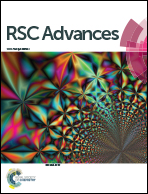A high efficiency ruthenium(ii) tris-heteroleptic dye containing 4,7-dicarbazole-1,10-phenanthroline for nanocrystalline solar cells†
Abstract
The tris-heteroleptic polypyridyl ruthenium(II) dye, cis-[Ru(cbz2-phen)(dcbH2)(NCS)2], cbz2-phen = 4,7-dicarbazole-1,10-phenanthroline and dcbH2 = 4,4′-dicarboxylic acid 2,2′-bipyridine, was designed, synthesized, purified via liquid chromatography and characterized using 1H NMR, FTIR, cyclic voltammetry, absorption and emission spectroscopy. The compound exhibits broad and intense MLCT bands that overlap the visible spectrum and it is capable of sensitizing TiO2 films. The energy levels of cis-[Ru(cbz2-phen)(dcbH2)(NCS)2] are adequate for its use in DSSCs. The solar cells prepared using this dye achieved a performance that surpasses N3 dye under the same conditions. The introduction of the extended π-conjugated carbazole substituent at the 4 and 7 positions of 1,10-phenanthroline increases the IPCE and the overall solar cell efficiency. The high performance is ascribed to the HOMO stabilization and to the increase in electron delocalization of the triplet excited state, which favors the electron injection via singlet and triplet pathways.

- This article is part of the themed collection: Luminescence and photophysical properties of metal complexes

 Please wait while we load your content...
Please wait while we load your content...